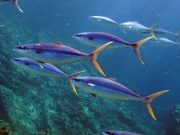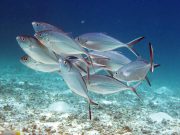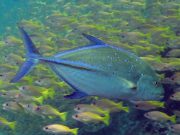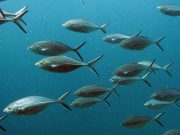Tauchen mit Jackfische, Makrelen und Stachelmakrelen
Meeresleben von Lanta | Carangidae
Die Familie der Carangidae umfasst etwa 200 Arten mittelgroßer bis großer Fische, darunter Stachelmakrelen, Läuferfische, Makrelen und Pompanos.
Die Körperformen variieren stark, von länglich und stromlinienförmig bis hin zu sehr tief und schlank, wobei viele Arten bei Tauchausflügen vor Koh Lanta leicht zu entdecken sind.
Jacks, Läufer und Trevallies haben zwei Rückenflossen, eine sehr schlanke Schwanzbasis und eine kräftige Schwanzflosse, die entweder gegabelt oder halbmondförmig ist. Sie haben kleine Schuppen, die manchmal schwer zu erkennen sind. Die meisten Arten sind schnell schwimmende Raubfische, die in den Gewässern über Riffen und im offenen Meer jagen.
Einige Arten sind fast vollständig silbrig, andere sind dunkel oder haben farbige Streifen oder Bänder auf Kopf, Körper oder Flossen. Einige Arten können ihr Muster verändern, und die Jungtiere vieler Arten haben Streifen oder Flecken, die mit zunehmendem Alter verblassen oder verschwinden.
5 Arten auf dieser Seite gefunden:
Rainbow Runner
(Elagatis bipinnulata)

Elagatis bipinnulata @ Koh Haa
The Rainbow Runner is a large fish, with a long, slender, silvery, darkish-blue body. The body has two lighter blue stripes, sometimes with yellowish stripe between them, and a large, forked tail. The fins are usually dark, with an olive or yellow tint.
The Rainbow Runner may grow to 120 cm, but usually observed in the 50 cm - 70 cm range. This is a fast-swimming pelagic species, usually seen in small schools on the outer reef edge. The diet includes small fish, squid, and a wide variety of planktonic crustaceans.
Barcheek Trevally
(Carangoides plagiotaenia)

Carangoides plagiotaenia @ Koh Haa
The Barcheek Trevally has a silvery body and is distinguished by a narrow dark bar on the gill cover, slightly protruding lower jaw and 'barred cheek' colouration.
This species grows to 42 cm and forms small groups in shallow water along the edges of steep outer reef and lagoon slopes.
The Barcheek Trevally's diet includes small fish and bottom-dwelling crustaceans.
Gold-Spotted Trevally
(Carangoides fulvoguttatus)

Carangoides fulvoguttatus @ Koh Bida
The Gold Spotted Trevally is often seen patrolling the reefs in small groups in search of food. The body is silvery with 5 faint dark vertical bars along the side and many small yellow or golden spots. In larger adults, there are 3 or 4 dark blotches along the middle of the side.
The Gold-Spotted Trevally grows to 130 cm, but more often observed in the 50 cm - 80 cm range. The diet includes shrimp, cephalopods and fishes. Small groups of 5 - 10 individuals are often seen hunting smaller species such as snapper and fusiliers along the reef edge, darting frantically in and out of fish schools to catch their prey. Occasionally groups of Gold-Spotted Trevally are seen forcing schools of fusiliers in deeper water to create 'bait balls' for protection.
Bluefin Trevally
(Caranx melampygus)

Caranx melampygus @ Koh Bida
The Bluefin Trevally has a tapered snout and a silvery bluish body with numerous blue and black spots on the upper half of the body and electric blue fins, except the pectoral fins, which are yellow.
The Bluefin Trevally is often seen in small groups hunting aggressively along the reef, attacking schools of smaller fish such as snappers and fusiliers. This species grows to 100 cm but more often observed 40 cm - 60 cm. The diet is mainly fish, but also includes cephalopods such as squid, and crustaceans.
Herring Scad
(Alepes vari)

Alepes vari @ Koh Haa
The herring scad has a greyish-blue to bluish-green upper body, fading to a silvery lower body. This species has two dorsal fins, the first of which is rather short. The tail fin can have a yellowish tinge to it, and males have darker fin tips than females, especially the tail fin lobes.
The numerous small scales give the body an appearance of vertical stripes or ridges.
The herring scad is the largest member of the scad genus Alepes, maximum length 56 cm, but more commonly observed around 30 cm.
Dense schools of herring scad can form close to the reef, swimming near the surface, high above the substrate (bottom). This species feeds mainly on small fish and crustaceans.
Tauchen mit Jackfische, Makrelen und Stachelmakrelen rund um Koh Lanta
Tauch- und Schnorchelausflüge
Wenn Sie gerne die Gelegenheit hätten, Jackfische, Makrelen und Stachelmakrelen auf einem unserer täglichen Tauchausflüge während der Hochsaison von Koh Lanta aus zu sehen, dann senden Sie uns eine E-Mail an info@diveandrelax.com.
Nehmen Sie an unseren Speedboot-Tauchausflügen in der Hochsaison zu einigen der besten Tauchplätze Thailands teil und genießen Sie kleine Gruppen, kurze Fahrzeiten und einen Fokus auf hervorragenden persönlichen Service, Sicherheit und Spaß.
Noch kein zertifizierter Taucher? Lernen Sie auf Koh Lanta das Tauchen mit dem 3-tägigen SSI Open Water Diver Kurs.
Buchen Sie online und sparen Sie 10% auf Tauchausflüge und Tauchkurse auf Koh Lanta.
Weitere Informationen
Indo-Pazifische Meereslebewesen-Führer
- Allen, G., Steene, R., Humann, P., DeLoach, N. (2003) Reef Fish Identification, Tropical Pacific. Jacksonville, FL., USA: New World Publications, Inc., ISBN 1-878348-36-1.
- Humann, P., DeLoach, N., (2010) Reef Creature Identification, Tropical Pacific. Jacksonville, FL., USA: New World Publications Inc., ISBN 978-1-878348-44-9
- Debelius, H. (2013) Indian Ocean Reef Guide. Frankfurt, Germany: IKAN - Unterwasserarchiv, ISBN 978-3-939767-52-7.
- Debelius, H. (2004) Nudibranchs and Sea Snails, Indo-Pacific Field Guide. Frankfurt, Germany: IKAN - Unterwasserarchiv, ISBN 3-925919-51-1
- Erhardt, H., Knop, D. (2015) Corals Indo-Pacific Field Guide. Frankfurt, Germany: IKAN - Unterwasserarchiv, ISBN 3-925919-69-4.
- Veron J.E.N., Stafford-Smith M.G., Turak E. and DeVantier L.M. (2016). Corals of the World
Weitere Referenzen zu Meereslebewesen und weitere Informationen
